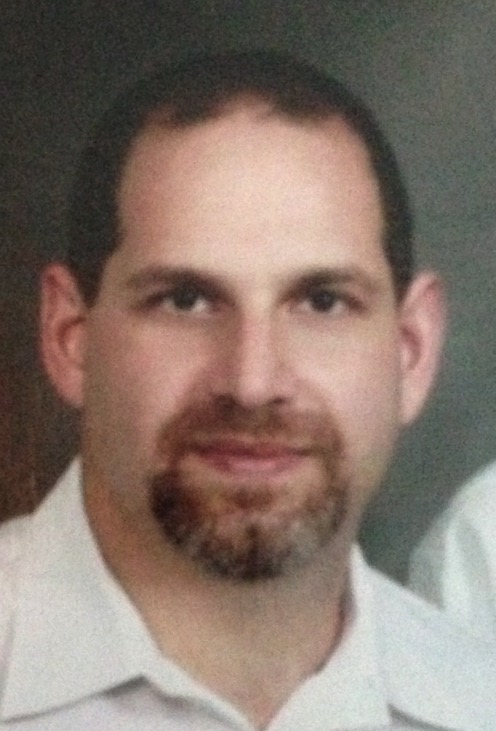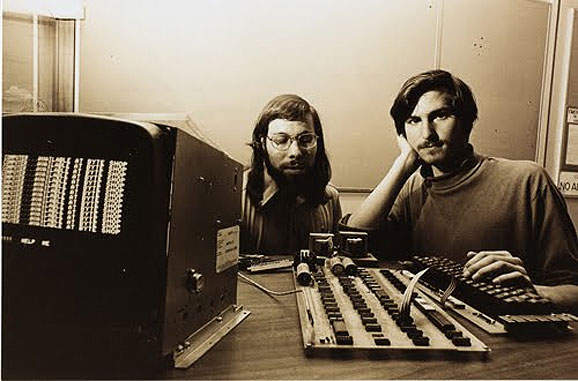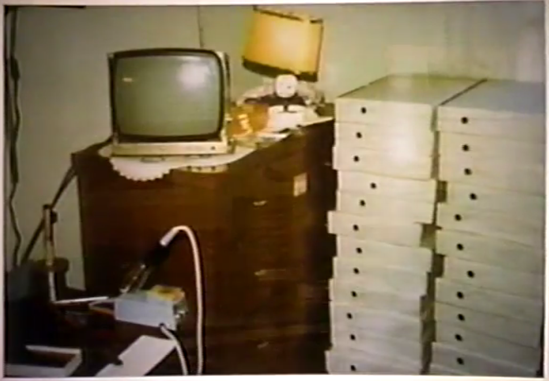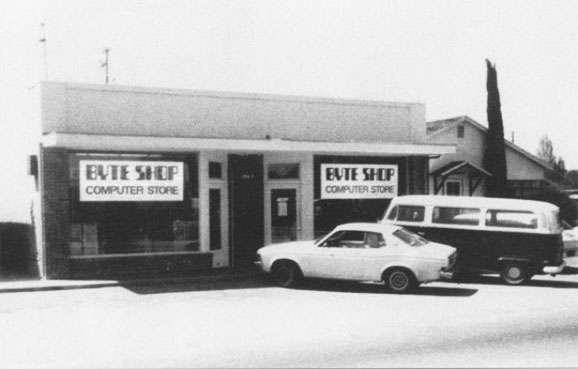The Apple-1 Story
So what does Atari, the Home Brew Computer club and a closet at Hewlett Packard have to do with building the first Apple Computer...
First some background...
Steve Jobs was working at Atari and Steve "Woz" Wozniak was working at HP. Woz worked in the calculator division until it was moved out of "silicon valley". Woz doesn't talk much about what he actually did at HP, other than he didn't have a degree yet, and was the go to guy if you needed a circuit designed using the least amount of chips. Remember HP at the time wasn't a consumer company, it was an engineering supply company. If it was technical equipment used by engineers, then HP made it. This is not how the company is today, since the purchase of Compaq, they are very much a consumer company (I should know, I did work there in a non-consumer division and felt like a second class citizen). Anyway back to Woz, now back then HP had a policy where anyone with manager approval could get "parts" from a closet to play around with. HP knew that products for engineers and ideas for product enhancements could come from anywhere in the company, maybe a guy in shipping or a guy on the assembly line had an idea that might help the company. So "free" parts!!!, the only catch, everything you design while working at HP, even on the side technically belonged to HP unless they released it.
More on this later...
Now Woz had always wanted a computer of his own, He and a friend even build a computer using discrete components called the "Ice-cream computer" that got him mentioned in the local paper, even though it caught on fire during the interview (for those fans of the movie Pirates in Silicon Valley, it was not Jobs with him at the time).
Woz spent a lot of time designing computers in his head and on paper. He didn't know what a "microprocessor" was nor did he care, but he played a game with himself where he could reduce the chip count but keep the functionality of a computer but only paper.
This was like a crossword puzzle or soduku game to him...
Now Steve Jobs was always trying to make a buck, he was always trying to figure out a way to get money. I'm not going to get into his ethics here about how he would "scam" free stuff, or lie to friends to keep a larger share, but he was a great talker. Jobs managed to talk himself into a Job at Atari. Ignoring Steve Jobs actual book, but using other sources it seems he did a lot of QA and fixing. Arcade games were all discrete components and really were difficult to design and troubleshoot. Many times, he would get Woz to help out at night so that the next day he could take credit for his work.
Since the infamous "blue-box" free phone call days of "Captain Crunch", Woz would design something and Jobs would figure a way out to sell it and make money. This included the TV Terminal design that Woz built so that he could communicate with friends. This was not the Don Lancaster TV terminal, but something else. Obviously there were some similarities.
The TV Terminal used many parts out of the "HP Closet" in it's design and was key in the design of the Apple-1...
In 1975, Gordon French and Fred Moore started the Homebrew Computer Club a place for local guys to get together and talk about computers and show off their ideas and new "toys". The push for this was the Altair 8800 computer which had hit the hobbyist computer scene, not the first computer, but the 1st one where it may actually be able to do something useful. The problem is the Altair was difficult to use without a lot of external "junk" like a terminal or punch tape reader, it was just a bunch of lights and switches without some serious work.
Woz was dragged to the Homebrew Computer Club by a friend, there he was introduced to the Microprocessor. Remember all those lower chip count computer designs he entertained himself with like crossword puzzles, well he realized that the microprocessor was the ultimate chip reducer. He grabbed some data sheets and started designing. With a microprocessor he could actually build one of these. Luckily someone was showing off MOS technologies new 6502 at one of the meetings. It was about 1/10 the cost of the 8800 CPU so that Woz could actually buy a few and not just do this on paper. Each week he would attend the club meetings and listen and design more.
Eventually he started building the computer that would become the Apple-1. At the time a computer, even a "home" computer like the Altair required a terminal to get "human" readable data in and out of the computer. Well Woz had one of those in his "TV Terminal" and a computer was useless until you loaded software into it, so learning from calculator group at HP, he could build a "Monitor" that booted the computer to a semi-usable state. Woz really just had to put it all together.
And he did...
Woz spent the next year just about perfecting his “computer”. He would bring it every week to the Home Brew Computer Club and show off what he had done. He gave away the schematics and the source code for the monitor. Woz spent a bunch of time helping people hand wire up their own computers from his schematics. This was what led to the creating of Apple. Steve Jobs approached Woz, one of his best friends and said they should have a PC board created to simplify the build process for members of the Home Brew Computer Club. Jobs told Woz they could get the board made for about $20 and sell them for $40. But first they had to get permission from HP. Why?
Well apparently HP owned everything that Woz designed as an employee using company resources. They had first shot...
Luckily, HP didn't want a computer for hobbyists. This was HP before they were the "printer" company and before they bought Compaq. This was HP the engineering equipment supply company. If HP built it, the product had to be to HP standards which were very high. The computer Woz built was not to that standard. It used a standard home television set and it was for hobbyists not engineers. Don't get me wrong many engineers were purchasers of Apple-1 computers when they became available, but the companies they typically worked at would never consider buying one to use for work.
So Woz was free to get the PCB professionally made and sell them...
Working at Atari, Steve Jobs knew of Howard Canton, the “go to” guy in Silicon Valley for having PC Boards laid out. They offered Howard a fiat wagon (not a VW Bus), Howard declined. So they paid him his standard fee of about $6-8 per chip and off he went.
Then came the infamous order for 50 completed units in 30 days....
At some point after the PCB layout was done, Steve Jobs cut a deal with the Byte Shop owner Paul Terrell at one of the Home Brew Computer Club meetings. Woz and Jobs would provide 50 complete computers and Paul would pay them cash.
This was the actual start of Apple. I won’t get into where the name came from; I have heard too many versions. Though I tend to believe Dan Kottke who says it came from the Apple orchard/commune that they would frequently visit in Washington State.
Steve Jobs asked Ron Wayne, a fellow Atari employee, who was to be the older and more responsible part of Apple. Ron was provided a 10% stake to help write out the partnership agreement and actual documentation to include with the computer.Steve Jobs then negotiated with PCB maker and parts house a “net-30” deal where they had 30 days to pay for the parts and PCB boards. The vendors even called the Byte Shop to confirm that the deal was real.After about two weeks, Ron Wayne sold his 10% back to Woz and Jobs out of financial fear of who would pay for the Byte Shop Order if something fell through. Since Ron was older, had assets and a family, this wasn’t an acceptable risk (something he is still OK with even today with Apple’s success)While it is unclear if the PCBs were completely populated in the initial run by the board manufacturer or were the chips inserted at Job’s parent house.
However according to Dan Kottke by the time he was hired on his summer breaks from college by “Apple”, Job’s sister and Dan were inserting the chips themselves. I can tell you that even if the board manufacturer put the chips in that didn’t mean they worked “out of the box”. The PCBs were “wave” soldered which could cause solder bridges and there were manual jumpers that needed to be soldered in before the boards could be tested and delivered to the Byte Shop. Using “wave” soldering was a unique and novel technique for a personal or hobby computer, but was the only way they could complete 50 machines in the 30 day time frame. Side note: This meant the Apple-1 was really partially assembled in the Jobs home and partially in a PCB factory, not hand soldered.
Back to the Byte Shop story….
In typical Steve Jobs fashion, there was “one more thing” that was a surprise to Paul Terrell at the Byte Shop. The Apple-1 as it was now called did not include a keyboard, case or transformers...
In Steve Job’s mind it was a complete computer and these other “accessories” the customer must provide. In Paul Terrell’s opinion, it was not a complete computer without these.
Steve Jobs convinced Paul that he could make money selling these “accessories”...
A local carpenter/furniture maker was contacted to produce a case. A keyboard, usually Datanetics, and two transformers were provided by the Byte Shop to their customers. In the end many customers just opted for the Apple-1 board so Paul was unloading his initial run of cases on much later Apple-1 sales. Today it is more common to find a later Apple-1 with the Byte Shop Kona-Wood case than one of the first 50 and even in that case they are very rare and collectible with only a handful know to still exist.
Paul also convinced Woz, he needed a cassette interface. Woz was still demonstrating his computer at the Home Brew Computer club and had just finished a “basic” language for the 6502. This “integer” basic would eventually reside in the Apple II as well. To demonstrate this basic, Woz would hand enter 4k worth of hexadecimal code into the Apple-1. Even with Woz’s great typing skills this could take up to an hour. He agreed an audio cassette interface was needed and would be cheaper and easier than a tape reader that many other hobby computers used.

You can contact me at corey@myapplecomputer.net
www.myapplecomputer.net


